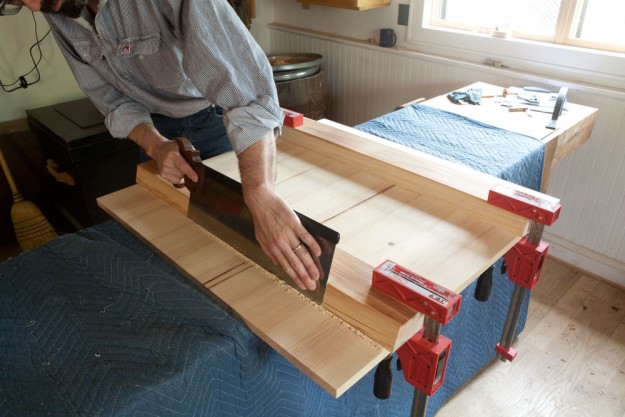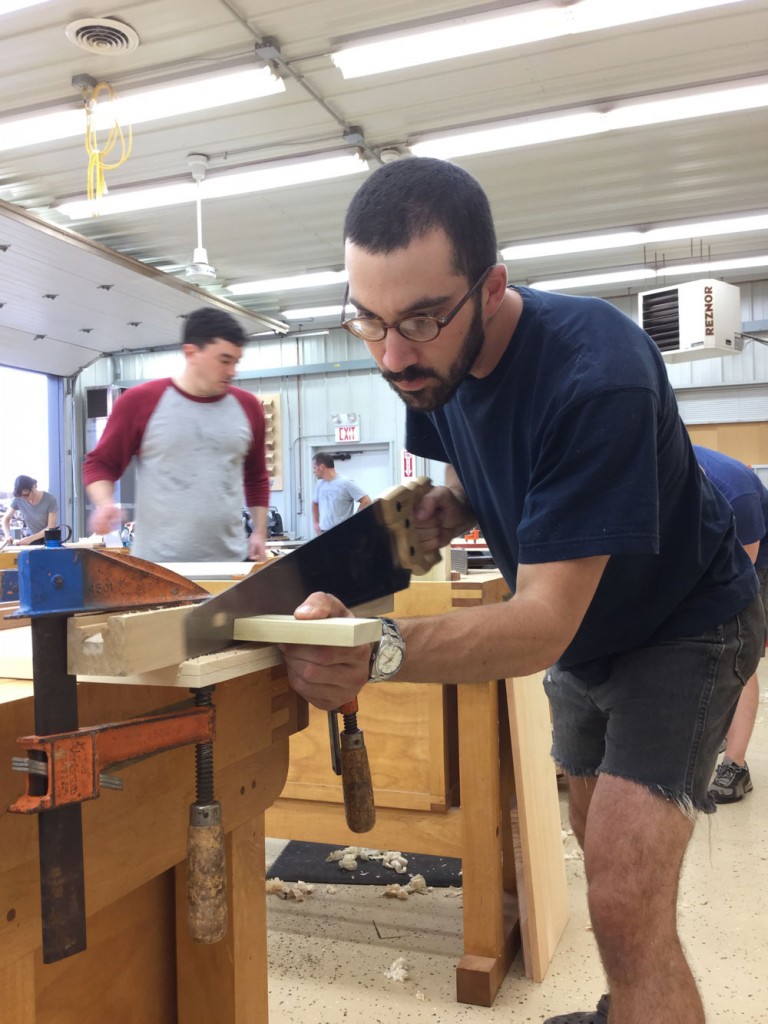We may receive a commission when you use our affiliate links. However, this does not impact our recommendations.
I’ve been cutting a lot of large-scale sliding dovetails and rabbets lately. And when these housed joints get to a certain size (think of a dovetail socket that is 4” wide and 30” long) it’s much more efficient to saw out the walls by hand.
When I need the rabbets or sliding dovetails to be bang-on, I clamp a batten to my work to guide the saw. I use a vertical batten for rabbets and an angled one for sliding dovetails.
The only tricky part about the joint is keeping the sawplate against the batten. Usually I use my fingers, but it’s easy to get the tips of your fingers shredded if you aren’t careful.
Then I saw a little trick in an old English woodworking magazine that turned on a lightbulb: Use a block of wood to press the sawplate to the batten. I started doing this in June, and it immediately made the joint easier to cut and more accurate.
Give it a try.
— Christopher Schwarz
Here are some supplies and tools we find essential in our everyday work around the shop. We may receive a commission from sales referred by our links; however, we have carefully selected these products for their usefulness and quality.











Great tip! Almost makes up for the flagrant display of cutoff jean shorts. Almost.
Looks like a single tine featherboard.
Nice!
Couldn’t you go one step futher, and clamp the offcut partner of the angled batten against the first batten — and then run the saw in the groove? Then you wouldn’t have to lean over and hold the little block of wood.
Much like a home-made mitre block — but tilting the sawplate sideways in the vertical plane — rather than pivoting it in the horizontal plane (but with a vertical sawplate) like a mitre block would do.
Dunno if that makes sense the way I wrote it.
–Gye Greene
Hi Chris
There are a number of better ways to make sliding dovetails. 🙂
Firstly, if you plan to saw the sidewalls (before removing the waste with a chisel/router plane), then keep a dedicated fence and inbed rare earth magnets along its length. Better still, do so on both sides (one side perpendicular for dados,and the other side at the dovetail angle of choice).
Secondly, I’ve built a number of planes for dovetails, both male and female (yes, the mind boggles). However, the latest one does both joint sides, and is so, so easy to make that everyone will want to try it out.
Simply, saw a dado and remove the waste. Then shape the sidewalls (one side only if you prefer) with the plane below. The same plane will also shape the male dovetail.
What is needed is a fence added to a Stanley #79 side rabbet plane …
http://www.inthewoodshop.com/Furniture/SlidingDovetails-LC_html_a837b5a.jpg
http://www.inthewoodshop.com/Furniture/SlidingDovetails-LC_html_680e7f25.jpg
Full details here … enjoy … http://www.inthewoodshop.com/Furniture/SlidingDovetails-LC.html
Regards from Perth
Derek
What a great idea. I have been using a batten for years to try and keep my sliding dovetails as accurate as possible. A block to keep the saw pressed against the batten is brilliant. Thanks for the tip.
I was taught this block against the blade trick little over a decade ago but it was with a reciprocating saw not a hand saw.
It’s funny how often these sorts of tips seem completely obvious and I can’t believe I did not think of it myself.
Thanks again, I’ve got breadboard rabbits to make for my American Trestle Table and this will come in handy.
Can”t thank you enough, Chris. It may be overkill, but I’ll also start using a block pressed against the side of my dado planes as well.